The historic centre of Pienza is quite small and flat, as part of a beautiful walk through its narrow streets, also following its large promenade that offers a splendid view over the hills dominated by the village.
Corso Rossellini in Pienza
You enter Pienza in the west through the Porta di Prato (or Porta al Murello) following the Corso Rossellini, the central artery of the historic center, passing right before the entrance to the gothic church of San Francesco, facing the Ammannati Palace.
It brings together most of the shops with the famous local gastronomic products.
Further on you reach the Piccolomini Palace and then the Piazza Pio II with the Duomo, the Borgia Palace, and continue until the Porta al Ciglio.
The street is named in memory of Bernardo Rossellino, the Florentine architect to whom Pope Pius II entrusted the task of transforming the village of Corsignano into the ideal city of the Italian Renaissance.
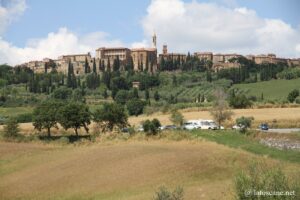
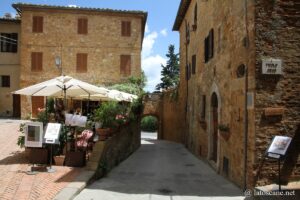
Piazza Pio II in Pienza
The trapezoidal Piazza Pio II (Pius II Square in English) is the heart of the historic centre, where the cathedral, the Palazzo Piccolomini, the Palazzo Borgia and the town hall are located.
In one corner, the beautiful Pozzo dei Cani (Well of the dogs in English) dates from the construction of the square, the inscription on the architrave from 1462 recalling the intervention of Pope Pius II.
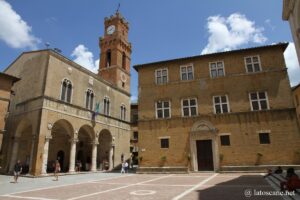
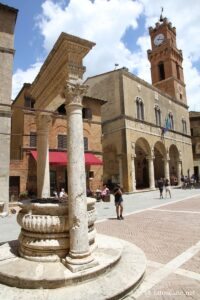
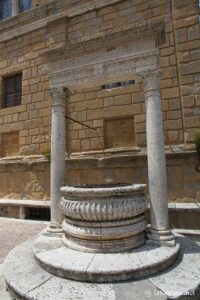
Pienza Cathedral
Piazza Pio II, the Pienza Cathedral (Duomo di Pienza in Italian), dedicated to Santa Maria Assunta, is an important building of the Italian Renaissance, whose interior is however of Gothic inspiration.
This dome was built with the new city between 1459 and 1462, after the destruction of the old Romanesque church, of which remains are found in the crypt San Giovanni. From the latter we also access the “labyrinth of the Dome”, set of tunnels used to consolidate the structure to avoid its collapse.
The central window of the church is reminiscent of German Gothic, the rest being Renaissance with its pilasters, tympanums, etc.
The interior of Gothic inspiration preserves paintings from the fifteenth century commissioned by Pius II to Sienese artists, a beautiful 15th century wooden choir, or the 15th century travertine tabernacle of the Blessed Sacrament.
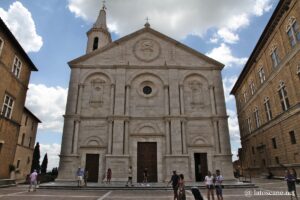
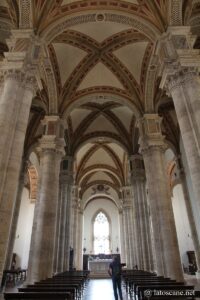
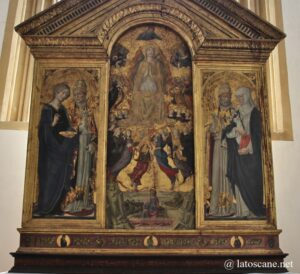
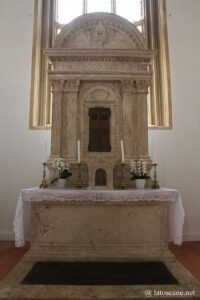
Borgia Palace and Diocesan Museum of Pienza
Behind a sober façade, the Borgia Palace houses the beautiful diocesan museum. It actually has two buildings, one of which was the residence of Cardinal Rodrigo Borgia, later to become Pope Alexander VI.
It was the episcopal palace. In the inner courtyard, you can see an old octagonal well.
The 11 rooms of the museum house a collection of art ranging from the Middle Ages to modern times, including furniture, jewelry, triptychs, altarpieces, Flemish tapestries from the 15th-16th centuries, sacred vestments, crucifix, etc. Mention should be made of the paintings of the Sienese school, with masters like Lorenzetti (including a famous Virgin and Child), Frà Bartolomeo della Porta, Signorelli or Bartolo di Fredi. The famous Piviale di Pio II (liturgical vestment of the pope) is a work in English with gold filigree and 150 figures embroidered with 27 scenes from the history of the Virgin.
Panoramic walk in Pienza
Behind the apse of the cathedral passes a pedestrian street that dominates the old ramparts of the city which connected the ancient towers. It is the Via del Casello (Toll street in English), with a view of the hills of the Val d’Orcia countryside. The view leads to Mount Amiata at 30 km, passing through Bagno Vignoni and Castiglione d’Orcia.
Remarkable alleys connect this promenade with Corso Rosselini: Via del Bacio, Via dell’Amore and Via della Fortuna.
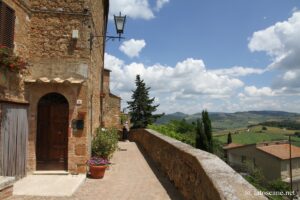
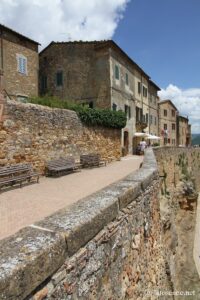
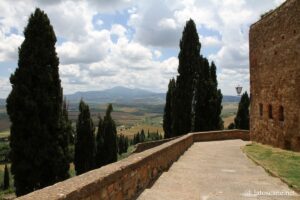
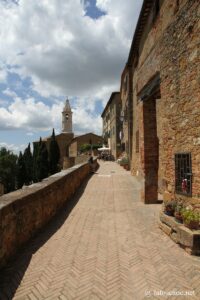
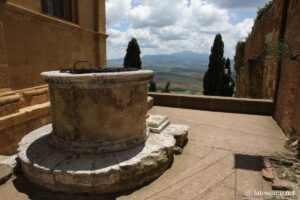
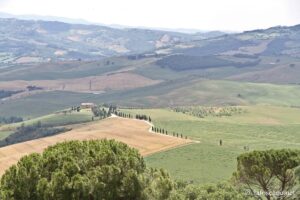
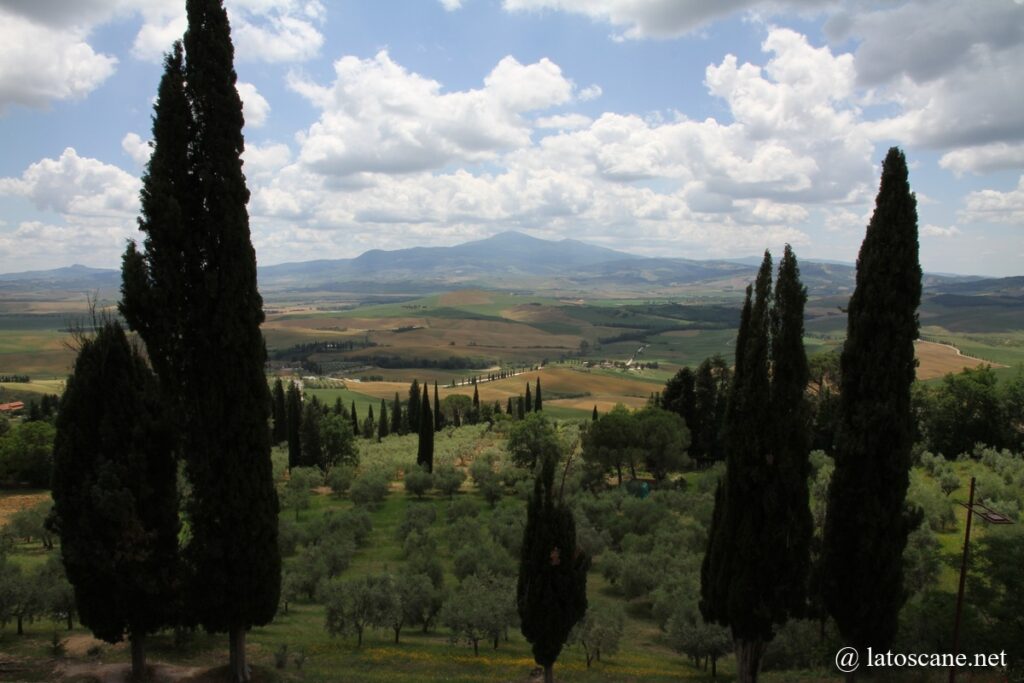
Palazzo Civico of Pienza
Piazza Pio II facing the cathedral, the Palazzo Civico (Town Hall in English) was designed by Rossellino, with a spacious portico with arcades. It was known as Palazzo Pubblico or Pretorio, former residence of the Podestà, the administrators of the city, whose coat of arms can be seen passing through the portico. It was somewhat reworked in the 20th century.
On the ground floor is a large porch with columns bearing ionic capitals with semicircular arches. On the side stands a tower with clock, lower than the neighbouring bell tower.
The interior preserves a splendid 15th century fresco in the Council Hall of a Virgin with the Child with the patron saints of the city (Vitus, Modest and Matthew).
Piccolomini Palace
Once called the Pontifical Palace, the majestic Piccolomini Palace also dates from the 15th century, inspired by the Rucellai Palace in Florence, built as a summer residence of Pope Pius II, designed by Bernardo Rossellino.
Its rectangular courtyard is surrounded by a three-storey loggia with colonnades. South side a panoramic garden overlooks the Val d’Orcia, typical of the Renaissance, with fountain and well.
It also preserves beautiful works of art, furniture, objects and the precious library.
Outside the palace, there are two wells attached to the walls.
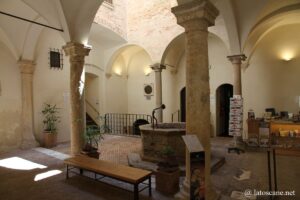
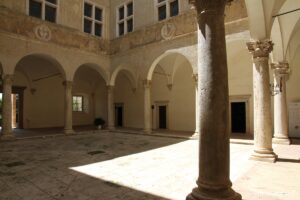
San Francesco Church
Part of a monastic complex, the San Francesco church (Saint-Francis church) is one of the oldest in the city. Dating back to the thirteenth century, it is typically Gothic and Franciscan with its single nave and sober.
The façade only counts the portal as a decorated element.
The interior is decorated with frescoes on the history of Saint Francis and others from the fourteenth century, with a beautiful wooden choir in the apse.
The cloister dates from the early 14th century, with an old circular well. The rooms of the convent now house a relais with 37 rooms. There is also a hanging garden.
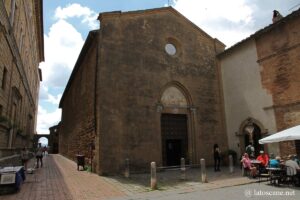
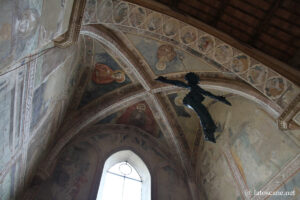
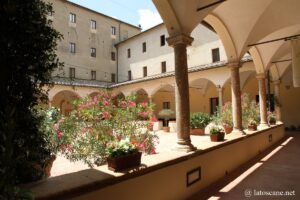
Corsignano Pieve
Outside the walls of Pienza, below the city, the priory Pieve Santi Vito e Modesto dates from the 13th century. This is the result of a reworking of a church from the 7th century. The oldest element is the Byzantine-inspired bell tower. The facade dates from the eleventh century.
The side portal is richly decorated with representations of the Three Kings and the Nativity.
Large pillars support the interior and there is an old small crypt.
Campi Elisi
From the priory of Carignano, the trail continues for a few hundred metres to cross the scenic Campi Elisi (Elysium in Italian), on the beautiful path where the final scene of the film The Gladiator was shot.
A path also joins the Madonna di Vitaleta Chapel almost 4 km from the priory, emblematic places of the Val d’Orcia with its cypresses.
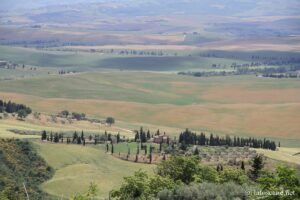
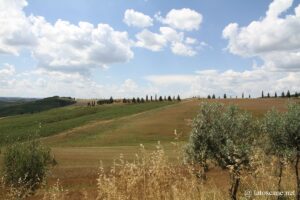
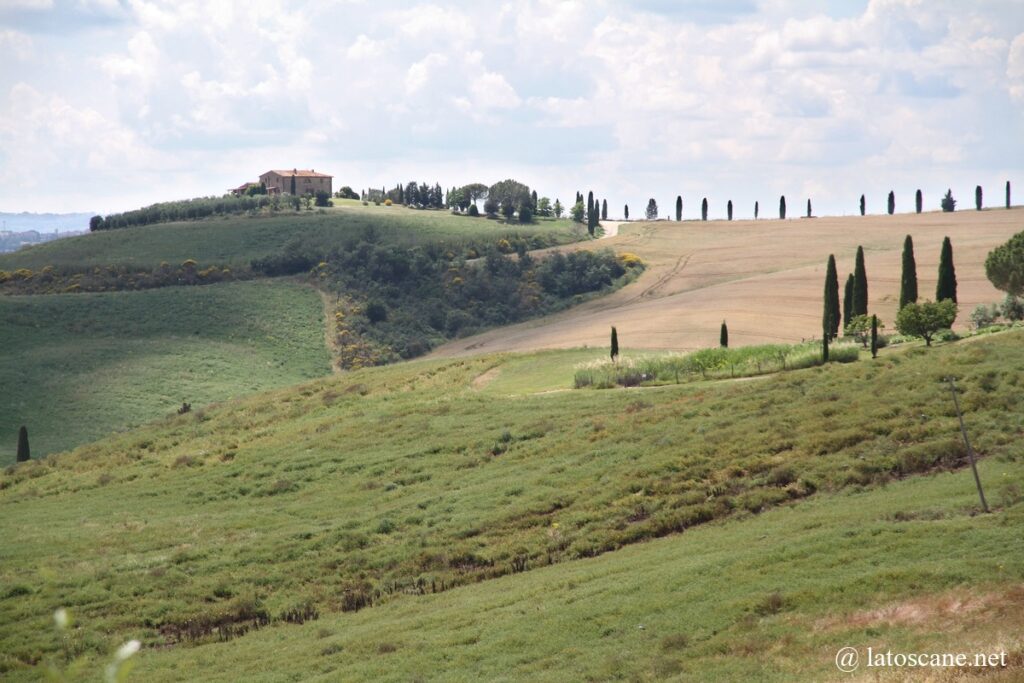
Other places in Pienza
Case Nuove
The Case Nuove (New Houses in English) district has twelve new houses, whose construction was planned around 1463, partly to accommodate the owners affected by the destruction to build Pienza, typical with their two floors and rounded windows. There is also a small well.
Porta al Murello Gate
The Porta al Murello is the northern entrance to the city, which has kept its medieval forms. In the arch is a fresco with the city represented under two angels symbolizing the protection of the Virgin on Pienza.
Porta al Ciglio Gate
The Porta al Ciglio is the southeastern entrance to the walls of Pienza, towards Monticchiello, with Corso Rossellino.
Piazza di Spagna Square
The small Piazza di Spagna close to Piazza Pio II was complementary to it, with the market and economic activities. There are now a few terraces of bars and restaurants, with an old circular well in the middle.
San Carlo Borromeo Church
The small San Carlo Borromeo church is part of the complex of the monastery of the Augustinian sisters, founded in the seventeenth century, transformed into a female conservatory at the end of the eighteenth century.
Santa Caterina Church
Dating from the end of the 17th century, the church Santa Caterina (St. Catherine) is outside Pienza, to the west, overlooking the priory of Carignano. There leads a long panoramic walk bordered by trees.
The façade is sober and the interior has a single nave with a baroque altar, a 14th century fresco of the Virgin and Child.
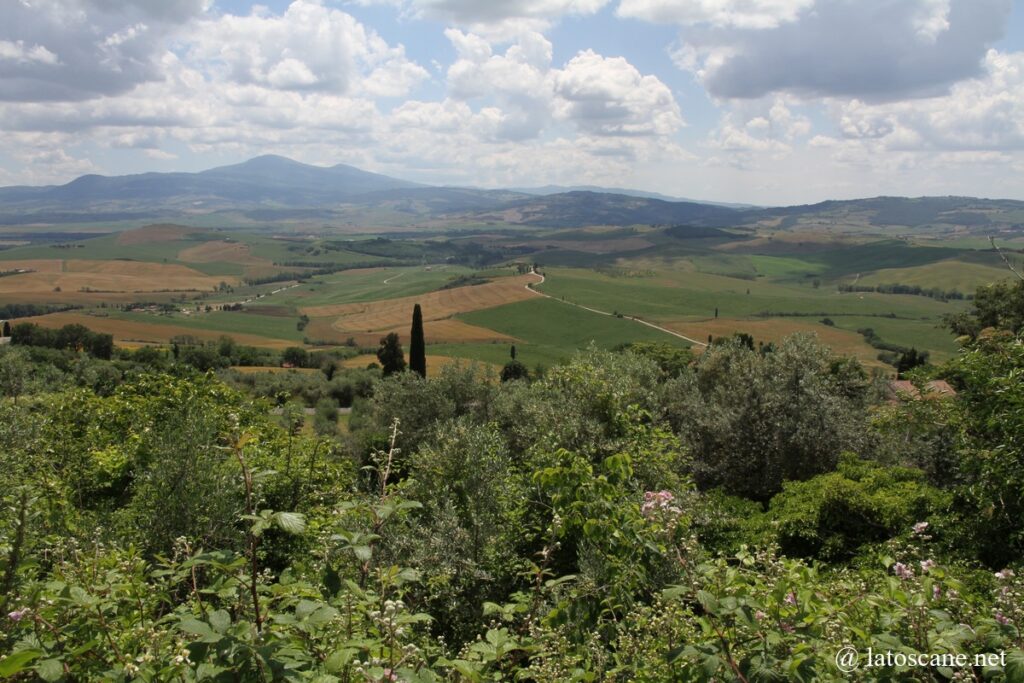
Surroundings
- See the post about Val d’Orcia, with Campi Elisi and Madonna di Vitaleta
Tourist map of Pienza
If you see this after your page is loaded completely, leafletJS files are missing.
Links and sources
- Official tourism site: www.pienzacittadiluce.it
- Pienza Cathedral: www.duomopienza.it
- Tourist portals: visitvaldorcia.it, www.lorenzotaccioli.it, www.noncieromaistatacom.com
Posts about Val d’Orcia and Pienza
- Pienza
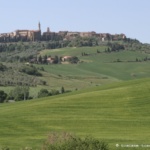 In the heart of Val d’Orcia valley and its unique landscapes lies Pienza, one of the most beautiful villages in Tuscany, in the south of the province of Siena, where ...
In the heart of Val d’Orcia valley and its unique landscapes lies Pienza, one of the most beautiful villages in Tuscany, in the south of the province of Siena, where ... - Hotels in Pienza
 Book accommodation in Pienza and its surroundings, among hundreds of structures including hotels, rooms, agritourism or apartments
Book accommodation in Pienza and its surroundings, among hundreds of structures including hotels, rooms, agritourism or apartments - Visits and tours in Pienza and around
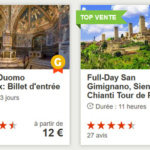 Suggestions of visits and activities in Pienza and the surrounding area, including tastings, visits to wineries, etc.
Suggestions of visits and activities in Pienza and the surrounding area, including tastings, visits to wineries, etc. - Weather in PienzaWeather forecast in Pienza, Tuscany, the weather today and in the next days, rainfall, temperatures and air quality.
- Val d’Orcia in Tuscany
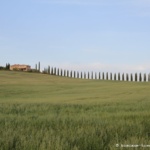 In the south of the territory of Siena, the Val d’Orcia is a famous tourist destination in Tuscany, with its landscapes of postcards emblematic of the region. Its harmonious countryside ...
In the south of the territory of Siena, the Val d’Orcia is a famous tourist destination in Tuscany, with its landscapes of postcards emblematic of the region. Its harmonious countryside ... - Montepulciano
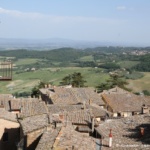 Montepulciano is a beautiful small town of almost 14,000 inhabitants, visited for its picturesque medieval center and by lovers of good wines. It is perched at 605 metres above sea ...
Montepulciano is a beautiful small town of almost 14,000 inhabitants, visited for its picturesque medieval center and by lovers of good wines. It is perched at 605 metres above sea ... - Pienza
 In the heart of Val d’Orcia valley and its unique landscapes lies Pienza, one of the most beautiful villages in Tuscany, in the south of the province of Siena, where ...
In the heart of Val d’Orcia valley and its unique landscapes lies Pienza, one of the most beautiful villages in Tuscany, in the south of the province of Siena, where ... - Montalcino in Tuscany
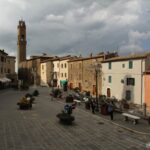 In the west of the Val d’Orcia, Montalcino is a Tuscan town famous for its Brunello, its excellent wine appreciated all over the world, made since the 19th century in ...
In the west of the Val d’Orcia, Montalcino is a Tuscan town famous for its Brunello, its excellent wine appreciated all over the world, made since the 19th century in ... - San Quirico d’Orcia in Tuscany
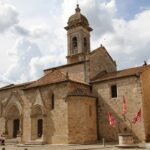 In the heart of the enchanting hills of the Val d’Orcia, San Quirico d’Orcia is one of the most beautiful villages in Tuscany, located on the pilgrimage route Via Francigena, ...
In the heart of the enchanting hills of the Val d’Orcia, San Quirico d’Orcia is one of the most beautiful villages in Tuscany, located on the pilgrimage route Via Francigena, ... - Castiglione and Rocca d’Orcia
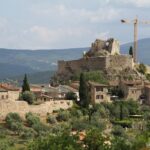 Castiglione d’Orcia Castiglione d’Orcia is a proud village in the Val d’Orcia, medieval town at the foot of its mighty 14th century Rocca Aldobrandeschi which dominates the entire valley from the ...
Castiglione d’Orcia Castiglione d’Orcia is a proud village in the Val d’Orcia, medieval town at the foot of its mighty 14th century Rocca Aldobrandeschi which dominates the entire valley from the ... - Abbadia San Salvatore, village of Mount Amiata
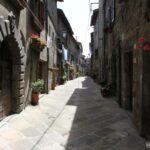 Abbadia San Salvatore is a characteristic village of Mount Amiata, the closest to the summit, at 800 meters altitude on the eastern side of the mountain. It is thus a ...
Abbadia San Salvatore is a characteristic village of Mount Amiata, the closest to the summit, at 800 meters altitude on the eastern side of the mountain. It is thus a ... - Bagni San Filippo and Vivo d’Orcia
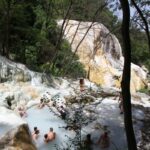 Bagni San Filippo On the eastern slopes of Mount Amiata, bordering the Val d’Orcia, Bagni San Filippo is a thermal village whose waters have been known since antiquity. Its hot, therapeutic ...
Bagni San Filippo On the eastern slopes of Mount Amiata, bordering the Val d’Orcia, Bagni San Filippo is a thermal village whose waters have been known since antiquity. Its hot, therapeutic ... - Bagno Vignoni, thermal village in Val d’Orcia
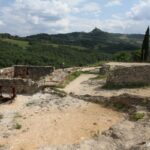 Located near the Via Francigena, between Castiglione and San Quirico, Bagno Vignoni is a small hamlet bathed by thermal waters used since at least the Roman times. Presentation The name of the ...
Located near the Via Francigena, between Castiglione and San Quirico, Bagno Vignoni is a small hamlet bathed by thermal waters used since at least the Roman times. Presentation The name of the ... - Abbey of Sant’Antimo in Tuscany
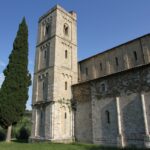 At 10 km south of Montalcino, the Abbey of Sant’Antimo has one of the most beautiful Romanesque churches in Tuscany, at the foot of the village of Castelnuovo dell’Abate, in ...
At 10 km south of Montalcino, the Abbey of Sant’Antimo has one of the most beautiful Romanesque churches in Tuscany, at the foot of the village of Castelnuovo dell’Abate, in ... - Cetona and surroundings in Tuscany
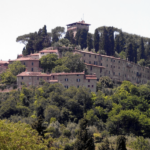 Village of Cetona Located on the slopes of the homonymous mountain, Cetona is a medieval town. For its various qualities, it is awarded the orange flag of the Italian Touring Club. ...
Village of Cetona Located on the slopes of the homonymous mountain, Cetona is a medieval town. For its various qualities, it is awarded the orange flag of the Italian Touring Club. ... - Radicofani
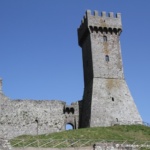 Radicofani stands out for its imposing medieval fortress, one of the most beautiful in Tuscany that dominates the Val d’Orcia with its beautiful eminence. It was long a strategic position ...
Radicofani stands out for its imposing medieval fortress, one of the most beautiful in Tuscany that dominates the Val d’Orcia with its beautiful eminence. It was long a strategic position ... - San Casciano dei Bagni in Tuscany
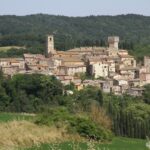 Close to the source of the Orcia and geographically indicated in the Val di Chiana Senese, San Casciano dei Bagni is a renowned thermal village surrounded by sources of sulphurous ...
Close to the source of the Orcia and geographically indicated in the Val di Chiana Senese, San Casciano dei Bagni is a renowned thermal village surrounded by sources of sulphurous ... - Sarteano in Tuscany
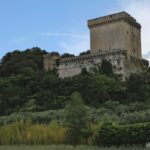 Sarteano is a village located between the Val d’Orcia and the Val di Chiana, few visited by tourists. Its castle is the main attraction, with the archaeological museum also very ...
Sarteano is a village located between the Val d’Orcia and the Val di Chiana, few visited by tourists. Its castle is the main attraction, with the archaeological museum also very ...
No Comments Yet